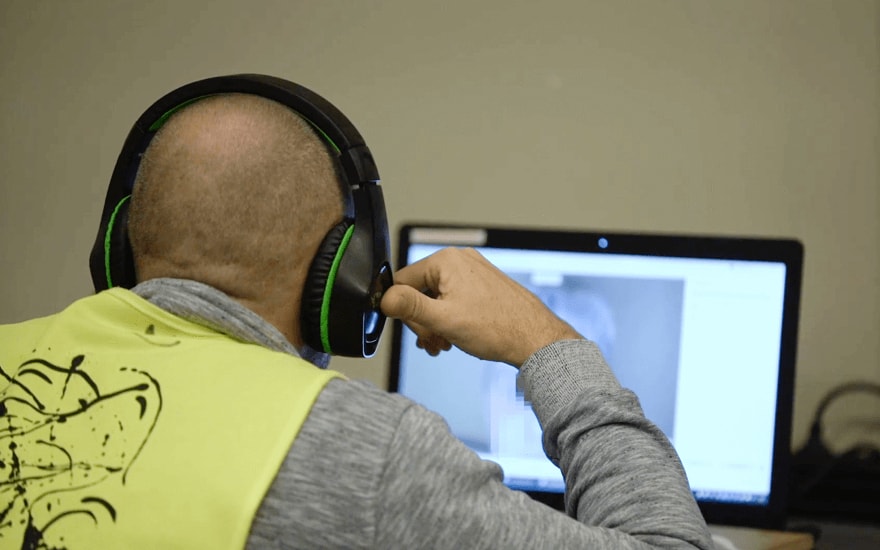Prisons are going digital
Published on 19/04/2021 in Customer Stories
Prisoners need to be able to prepare for reintegration in society in a controlled and safe way. That is the goal behind the digitalization of prisons.

The corona crisis has accelerated the digitalization of prisons. “When prison visits had to stop because of lockdown, we developed an alternative with video-visits via Cisco Webex”, says Kristoff Hemelinckx, director of ICT in the detention service.
“Once we’d opted for Cisco Webex, things moved really fast”, says Kris Lambert, of the ICT department of the detention service. Areas are set up in the prison for video-visits, with a dedicated laptop for this purpose. The laptop is also screened off so that the prisoner cannot touch it.
Low threshold
The prisoner requests the video-visit via a reservation system. The IT service produced a practical manual in several languages for this purpose. The decision to go with Cisco Webex has kept the threshold for using video very low. “Anyone who knows how to use Facebook on a smartphone will have no problem with Cisco Webex”, said Kris Lambert.
“Video offers real added value”, says Paul Dauwe, who knows this from experience. He is the director of the prison in Hasselt, where they have a separate room with six laptops for video-visits. That means they can organize video-visits for a maximum of ninety prisoners per day. “Not only does the prisoner see the visitor, they can also see the living room or a pet. They feel more connected with their family. So, the video-visit actually complements the physical visit. They can also talk to family abroad. So we’ll continue offering video even when the Corona crisis is over.”
Video offers real added value. It complements the physical visit.
Paul Dauwe, director of the prison in Hasselt.
In step with our digital society
The idea behind the digitalization of the prisons goes beyond video. The revolution occurring in society needs to take place in prisons too – in a controlled and safe way. Those leaving prison at the end of their sentences have to be able to join our digital society. “That’s another reason why we are turning prisons into a digital environment”, said Kristoff Hemelinckx.
“Eventually prisoners will be able to take initiative themselves from their cells: for example, following an online course or looking for a job.” “Prisoners can also converse with their contacts at VDAB, OCMW or a center for mental well-being”, said Paul Dauwe. “With every positive experience, the interest in video grows.”
That also applies to the wider operations of the detention service itself, and also for the Justice department. “Video obviously can’t replace all contact with the court or lawyers. But for some appointments – for example, consulting a file – there’s no real added value in going to court. There, digitalization – and video too – can definitely play a role.”
Video conferencing and digitalization in the courts
The prisoner must be able to prepare for reintegration in the digital society from inside prison.
Kristoff Hemelinckx, director of ICT in the detention service
Online courses
Training remains a major spearhead of digitalization. Rather than the traditional training on paper, everything will now be digital. “There are a number of courses for which prisoners can already take their exams online, for the examination board for second-chance education”, said Kris Lambert. “They follow the lessons online, either live or recorded. And they can now take oral exams via Webex as well.” In the prison in Hasselt there is also a prisoner who is following lectures via video – on a deferred basis – at the KU Leuven.
One thing is certain: there is no shortage of projects. VoIP will be available in the cells so that prisoners no longer have to make calls in the corridor; and digital television is also underway. In time, that digital device will evolve into a service platform, for purchasing products from the canteen, ordering a film or borrowing a book, among other things. The new prison complex in Haren – which will open in September 2022 – will be the first to use the new platform.
Support
A digitalization project can only succeed if there is enough support for it. And the same is true in prisons. “You need the whole organization behind you”, said Kristoff Hemelinckx. “And sometimes that requires time. But we’re getting there. We’re looking at the use of 4G and tablets, something that has been strictly forbidden up to now.”
From a broader perspective, digitalization also reflects the mission of the detention service. “Sometimes you have to remove a person from society for a while,” said Paul Dauwe. “But at the same time it is our duty to invest in those people so that their time in prison is not wasted.”
Watch the video
Paul Dauwe has worked for the past 35 years in the prisons of Dendermonde, Merksplas and Leuven. Since 2013 he has been director of the prison in Hasselt.
Kristoff Hemelinckx is director of ICT in the detention service.
Kris Lambert works in the ICT department for the detention service.
Video calls from any location?
One
One magazine is the Proximus B2B magazine for CIOs and IT professionals in large and medium-sized organisations.